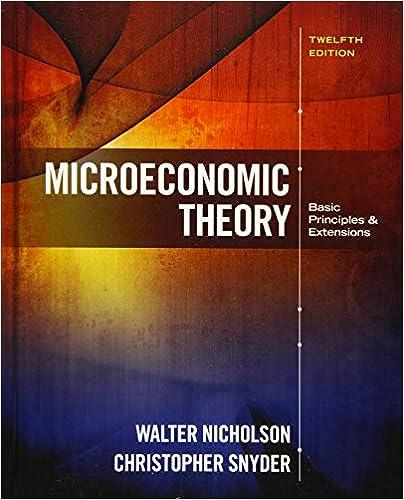Shipping the good apples out Details of the analysis suggested in Problems 6.5 and 6.6 were originally
Question:
Shipping the good apples out Details of the analysis suggested in Problems 6.5 and 6.6 were originally worked out by Borcherding and Silberberg (see the Suggested Readings) based on a supposition first proposed by Alchian and Allen. These authors look at how a transaction charge affects the relative demand for two closely substitutable items. Assume that goods x2 and x3 are close substitutes and are subject to a transaction charge of t per unit. Suppose also that good 2 is the more expensive of the two goods (i.e., “good apples” as opposed to “cooking apples”). Hence the transaction charge lowers the relative price of the more expensive good [i.e., 1p2 1 t2/ 1p3 1 t2 decreases as t increases]. This will increase the relative demand for the expensive good if
∂ 1xc 2/xc 32/∂t . 0 (where we use compensated demand functions to eliminate pesky income effects). Borcherding and Silberberg show this result will probably hold using the following steps.
a. Use the derivative of a quotient rule to expand
∂ 1xc 2/xc 32/∂t.
b. Use your result from part
(a) together with the fact that, in this problem, ∂ xc i/∂ t 5 ∂ xc i/∂ p2 1 ∂ xc i/∂ p3, for i 5 2, 3, to show that the derivative we seek can be written as
∂ 1xc 2/xc 32
∂ t 5 xc 2
xc 3
c s22 x2 1 s23 x2 2 s32 x3 2 s33 x3 d , where sij 5 ∂ xc i/∂ pj
.
c. Rewrite the result from part
(b) in terms of compensated price elasticities:
e c
ij 5 ∂ xc i
∂ pj
#
pj xc i
.
d. Use Hicks’ third law (Equation 6.26) to show that the term in brackets in parts
(b) and
(c) can now be written as 3 1e22 2 e232 11/p2 2 1/p32 1 1e21 2 e312/p34.
e. Develop an intuitive argument about why the expression in part
(d) is likely to be positive under the conditions of this problem. Hints: Why is the first product in the brackets positive? Why is the second term in brackets likely to be small?
f. Return to Problem 6.6 and provide more complete explanations for these various findings.
Step by Step Answer:

Microeconomic Theory Basic Principles And Extensions
ISBN: 9781305505797
12th Edition
Authors: Walter Nicholson, Christopher M. Snyder






